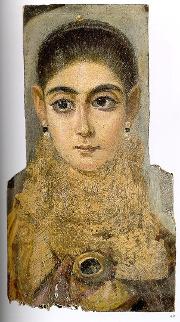The word "ENCAUSTIC" originates from the Greek word 'enkaustikos' which means to burn in.
The element of heat is necessary for a painting to be called Encaustic and is made with natural Bee's Wax combined with Damar Resin to raise the melting temperature and to harden the wax (to 100 °C or 212 °F). It is heated with a high temperature trade heat gun (not a hairdryer!) or a gas flame torch, and can cope with high environmental temperatures without melting off. So even if you hang the art near a fire place/heater it will not melt.
Encaustic Wax is inert and has an extremely long archival property.
This technique, one of the most highly regarded forms of art in the Classical world, dates back to 100-300 AD with examples of the medium still in existence, notably the Fayum mummy portraits from Egypt (shown here: Mummy portrait of a young woman, 3rd century, Louvre, Paris), as well as in many works of 20th-century artists.
Each piece is produced with multiple layers (sometimes as many as 20), with each layer heat fused to the previous layer. Pigment is added on each layer or mixed within the molten wax.
For more historic information, visit HERE
How to care for your encaustic wax artwork
As for all artwork, it should not be subject to direct sunlight. This is to preserve the pigments. Should you need to travel with your art on a very hot day, the piece should be left flat. The wax will not melt or distort but may be soft on the surface, which will reharden when cooled, but do not lay any heavy objects over the art.
Just treat it as you would any watercolour/acrylic/oil painting (none of them like sharp objects!) however the added bonus is you can give your piece a polish with a soft cloth to bring up the shine and remove dust every 6-12 months.
I love working with encaustic wax. It has an earthy, natural feel and inspires me with every piece I create....always different and often a special surprise!
Enjoy!
Cate Bell
© Copyright Cate Bell Art Design
